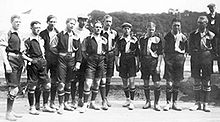Swedish Football Association
| UEFA | |
|---|---|
 | |
| Founded | 18 December 1904 |
| Headquarters | Solna |
| FIFA affiliation | 21 May 1904 |
| UEFA affiliation | 1954 |
| President | Karl-Erik Nilsson |
| Website | svenskfotboll.se |



The Swedish Football Association (Swedish: Svenska Fotbollförbundet) also known as SvFF is the governing and body of football in Sweden. It organises the football leagues – Allsvenskan for men and Damallsvenskan for women – and the men's and women's national teams. It is based in Solna and is a founding member of both FIFA and UEFA. SvFF is supported by 24 district organisations.
Background[]
Svenska Fotbollförbundet (SvFF) (English:Swedish Football Association) was founded in Stockholm on 18 December 1904[1] and is the sports federation responsible for the promotion and administration of organised football in Sweden and also represents the country outside Sweden. SvFF is affiliated to the Swedish Sports Confederation (RF) and the Fédération Internationale de Football Association (FIFA) and Union of European Football Associations (UEFA).
Karl-Erik Nilsson has been the President since 2012. In 2009 there were 3,359 clubs affiliated to the Svenska Fotbollförbundet with a total of more than a million members, of whom about 500,000 were active players. Together, they accounted for almost one third of the total Swedish sports movement activities.[2]
SvFF administers the Swedish men's respectively women's national football teams, other football teams and leagues including the Allsvenskan and Superettan. The motto of Swedish football – "one club in every village, football for all" – is reflected in the democratic constitution of Swedish football. All football competition in the nation is arranged by the SvFF and its 24 district organisations. The clubs are voting members at the annual meetings of the district organisations. The district organisations and the elite clubs are entitled to vote at the F.A.'s general meeting.[3]
SvFF was the sole owner of Sweden's national stadium, the Råsunda Stadium in Solna, from 1999 until it was replaced in 2012 by Friends Arena, located about 1 kilometer away and also in Solna. SvFF is the lead partner in the consortium that owns the current stadium, and maintains its offices there (as it did at the prior stadium).[3]
The Swedish Football Association Football Gala is held annually in November since 2005. It includes the award for the best male player (Guldbollen) and female players (Diamantbollen).
SvFF had a turnover 2008 of 554 MSEK.[3]
Early history[]
The first Swedish national football championship was played in 1896 but it was 7 years later in 1903 that the Riksidrottsförbundet was formed which was to be the precursor to the Svenska Fotbollförbundet. The new organisation had a football and hockey section (hockey being the term for bandy at that time and not ice hockey or field hockey). In 1904 Sweden was one of 7 nations that founded FIFA.[4] It also introduced ice hockey to Sweden in 1920, before the 1922 establishment of the Swedish Ice Hockey Association. Before the 1925 establishment of the Swedish Bandy Association, the Swedish Football Association also administered organized bandy in Sweden.
In 1906 the name Svenska Fotbollförbundet (Swedish Football Association) was officially accepted and the following year SvFF was officially voted into FIFA. On 12 July 1908, Sweden's first international match was played in which Norway were defeated 11–3 in Gothenburg. However the Olympics were a disappointment for Sweden, losing 1–12 to England and 0–2 to the Netherlands.[4]
Competitions[]
| Swedish Football League Structure |
|---|
|
Allsvenskan (Tier 1) |
| Swedish Football Women's League Structure |
|---|
|
Damallsvenskan (Tier 1) |
Svenska Fotbollförbundet is responsible for organising the following competitions:
Men's football[]
- Allsvenskan (Tier 1)
- Superettan (Tier 2)
- Division 1 (Tier 3) – two sections
- Division 2 (Tier 4) – six sections
- Division 3 (Tier 5) – twelve sections
- – two sections
Women's football[]
- Damallsvenskan (Tier 1)
- Elitettan (Tier 2)
- Division 1 Norrettan (Tier 3)
- Division 1 Söderettan (Tier 3)
- Division 2 (Tier 4) – nine sections
Junior[]
- Juniorallsvenskan
- Pojkallsvenskan
Cups[]
- Svenska Cupen – Men
- Svenska Cupen – Women
- CANAL+-cupen – Junior Boys
- Cup Kommunal – Junior Girls
Honours[]
Men's[]
- FIFA World Cup
- Third place (2013)
- Winners (2015)
- Runners-up (1992)
Women's[]
- Runners-up (2016)
- Runners-up (2013)
District Football Associations[]
Swedish football is built on a single pyramid league system. While the SvFF administers the top leagues, the 24 district or regional associations administers youth football and the lower tier leagues from Division 4 (men) and Division 3 (women), respectively, and further below.[5]
The 24 district organisations are as follows:[6]
- Blekinge Fotbollförbund
- Bohusläns Fotbollförbund
- Dalarnas Fotbollförbund
- Dalslands Fotbollförbund
- Gestriklands Fotbollförbund
- Göteborgs Fotbollförbund
- Gotlands Fotbollförbund
- Hallands Fotbollförbund
- Hälsinglands Fotbollförbund
- Jämtland-Härjedalens Fotbollförbund
- Medelpads Fotbollförbund
- Norrbottens Fotbollförbund
- Skånes Fotbollförbund
- Smålands Fotbollförbund
- Södermanlands Fotbollförbund
- Stockholms Fotbollförbund
- Upplands Fotbollförbund
- Värmlands Fotbollförbund
- Västerbottens Fotbollförbund
- Västergötlands Fotbollförbund
- Västmanlands Fotbollförbund
- Ångermanlands Fotbollförbund
- Örebro Läns Fotbollförbund
- Östergötlands Fotbollförbund
Footnotes[]
- ^ Åke Jönsson (25 February 1904). "Avspark på hemmaplan: Hundra år med fotboll". Populär historia (in Swedish). Retrieved 14 March 2020.
- ^ "The Swedish FA – Svenskfotboll.se". Retrieved 2011-01-11.
- ^ a b c "Swedish Football of Today – Svenskfotboll.se". Retrieved 2011-01-11.
- ^ a b "Milestones of Swedish Football – Svenskfotboll.se". Retrieved 2011-01-11.
- ^ "The Swedish League System – Svenskfotboll.se". Retrieved 2011-01-11.
- ^ "Kontaktuppgifter och tävlingar – Svenska Fotbollförbundet – Svenskfotboll.se". Retrieved 2011-01-10.
External links[]
- Swedish Football Association (official website)
- Sweden at FIFA site
- Sweden at UEFA site
- Swedish Football Association
- UEFA member associations
- Football in Sweden
- Futsal in Sweden
- Sports governing bodies in Sweden
- Football governing bodies in Sweden
- 1904 establishments in Sweden
- Sports organizations established in 1904
- Defunct bandy governing bodies
- Defunct ice hockey governing bodies
